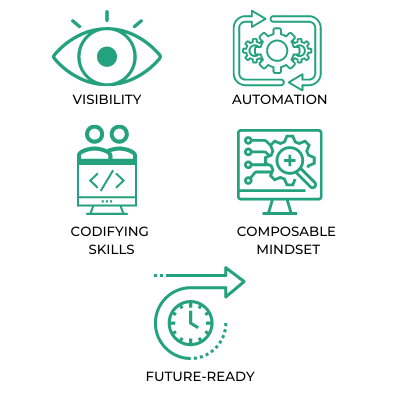
The 5 building blocks of continuous resilience
Visibility, automation, composability, codifying skills and being future-ready - these are the building blocks for continuous resilience and compliance with Digital Operational Resilience regulations.
2022: The Year of Resilience
Technological complexity, reliance on third-party providers, massive (costly) public outages and an unforeseen skills crisis: it's no wonder Gartner cite resilience as their Top Strategic Tech Trend for 2022: the requirement for resilience now drives 2/3 of emerging technology investments for 2022 a and beyond.
Regulatory concern over Digital Operational Resilience has been bubbling away for years, but with the implementation period for the FCA's regulations coming to a close in March and the EU's Digital Operational Resilience Act likely to pass, it's about to boil over.
By March 2022 regulated firms must comply with FCA and PRA rules.
The FCA's implementation period comes to an end in March 2022. Regulated firms must have identified critical business services and mapped them to their supporting applications. Firms must also have defined and set impact tolerances for outages and outlined how they intend to reduce third party risk.
Our guide to resilience regulation provides practical guidance for technology leaders to help towards compliance - and deliver continuous resilience.

The 5 building blocks of continuous resilience
The tech reality for large enterprises is a complex one.
Legacy and on-prem, private cloud, public cloud, SaaS, PaaS, Kubernetes and containers...chances are something, somewhere is failing and it’s going to take alot more effort and time than you’d like to find it and fix it.
The good news is that there are building blocks to put in place to help you build a continuously resilient foundation for now and which adapts to the future.
Visibility
Delivering continuous resilience means you need to really understand your entire hybrid estate, and you can only do that by having a living, breathing, interrogable model of your critical business services, the applications which underpin them and their environments and their dependencies.
Organisations which have achieved this level of visibility are able to immediately identify an issue, its blast radius and its solution, slashing downtime and its cost.

Automation
You need to assume failures will happen. Manual recovery processes take time, are costly both in terms of staff and business impact. By automating incident detection, response and recovery, you significantly reduce the impact of failures and save on the massive costs of downtime.
Gartner’s 2021 IT Skills Roadmap places automation as the most critical capability in the highest demand, precisely because of the efficiency and innovation benefits these skills bring.

Codified skills
The ‘Great Resignation’, combined with the ‘Great Retirement’, presents particular challenges for enterprises who often rely on a complex hybrid of heritage and modern technologies - and the skill sets required to run them.
To resist the skills squeeze, enterprises need solutions to codify these heritage skillsets, integrate them with modern architectures and deploy the automation capabilities that will free up existing employees to innovate, learn and explore.

Composable mindset
58% of IT leaders have compliance concerns related to application sprawl: a sprawling application environment, provisioned with little or no involvement from IT teams, increases the resilience risk surface, and total cost of ownership.
Thinking 'composably' means thinking of applications as packaged business capabilities, rather than discrete products used by separate teams. Applications can be designed, assembled and integrated to provide tailored solutions, reining in sprawl and reducing resilience risks.

Future-ready
Resilience isn't about hitting reset when failures occur. It's about learning what went wrong and reducing the impact next time round. Continuous resilience is, well, continuous.
A Digital Platform Conductor tool like Cloudsoft AMP helps you to think more ‘composably’ - by breaking down your critical business services into the applications that support them and automatically managing them throughout their lifecycles.
AMP's blueprints and policies allow you to build resilience and flexibility into your critical business services, keeping them optimised in times of stability and recovering quickly in times of instability.
Ready to be continuously resilient? Let's talk.
The goal of continuous resilience is to minimise disruption to critical business services, and the impact this has on your customers; and your bottom line - and according to IDC, the true cost of downtime exceeds $250m a year for Tier 1 banks.
A Resilience Readiness Assessment will look at technical aspects of your estate, such as visibility, automation, composability and codification of skills, as well as strategic business dimensions like Regulation and ESG, to help set you up for a continuously resilient future - whatever it throws at you.


Digital Platform Conductors
Increasing complexity is a widely acknowledged challenge to enterprise digital transformation.
A recent Innovation Insight from industry analysts Gartner highlights that managing this level of complexity means taking a workload or application-level view - managing the service, rather than the infrastructure.
Gartner call the tooling which can deliver this Digital Platform Conductors, of which Cloudsoft have been named as a representative vendor!
Download our infographic to learn more about how Digital Platform Conductors manage workloads across any environment.

Customer Stories

AMP reduces toil by 75%, and MTTR by 95%, for a Global Bank
Learn more




